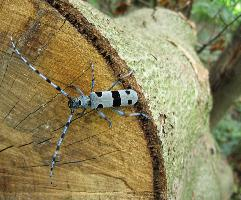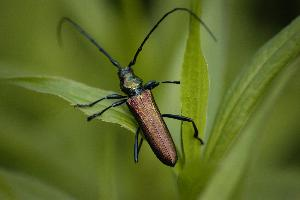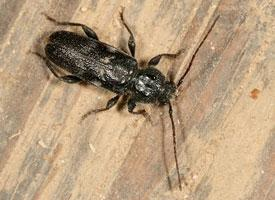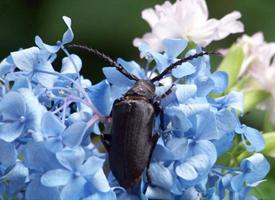
Poids et mesures
| Longueur | de 15 à 38 mm |
|---|
Statut de conservation
| Menacé |
Description de l'animal
The Rosalia longicorn, scientifically known as Rosalia alpina, is a strikingly beautiful species of longhorn beetle, belonging to the family Cerambycidae. This species is particularly noted for its distinctive coloration and elongated body, making it a subject of interest not only among entomologists but also nature enthusiasts and conservationists.Adult Rosalia longicorns typically measure between 15 to 38 millimeters in length. Their bodies are slender and elongated, a characteristic feature of the longhorn beetle family. The most remarkable aspect of their appearance is their coloration; they sport a mesmerizing pale blue or bluish-grey hue, interspersed with black spots. This unique color scheme not only makes them visually appealing but also provides them with a certain level of camouflage against predators in their natural habitat.
Another distinctive feature of the Rosalia longicorn is its long antennae, which can extend up to twice the length of its body. These antennae are not just for show; they play a crucial role in the beetle's sensory perception, helping it to navigate through its environment, find mates, and locate suitable sites for laying eggs.
The Rosalia longicorn is primarily found in the deciduous forests of Europe, with its range extending from the Iberian Peninsula in the west to the Caucasus and Iran in the east. It has a particular affinity for old, mature forests, especially those dominated by beech and oak trees. The larvae of the Rosalia longicorn are wood-borers, feeding on the decaying wood of these trees, which makes the species an important part of the forest ecosystem, contributing to the decomposition process and nutrient cycling.
However, the Rosalia longicorn's reliance on old-growth forests has also made it vulnerable. Habitat loss due to deforestation, logging, and changes in land use has led to a decline in its population across much of its range. Consequently, the species is considered to be near threatened, with several countries implementing conservation measures to protect its habitat and ensure its survival.
Conservation efforts for the Rosalia longicorn involve protecting its natural habitat, especially the old-growth forests it depends on for survival. This includes the establishment of protected areas, the implementation of sustainable forest management practices, and the restoration of degraded habitats. Public awareness and education campaigns are also crucial in garnering support for the conservation of this remarkable beetle and its ecosystem.
In summary, the Rosalia longicorn (Rosalia alpina) is a captivating species of longhorn beetle, admired for its unique coloration and significant ecological role. Despite facing challenges due to habitat loss, ongoing conservation efforts aim to secure a future for this enchanting creature and the ancient forests it calls home.
Animaux similaires
Nouvelles photos d'animaux
Top 10 des animaux
- Dolphin gull (Leucophaeus scoresbii)
- Diana monkey (Cercopithecus diana)
- Moustached guenon (Cercopithecus cephus)
- Galápagos tortoise (Geochelone nigra complex)
- Russian tortoise (Testudo horsfieldii)
- Japanese macaque (Macaca fuscata)
- Stone loach (Barbatula barbatula)
- Greek tortoise (Testudo graeca)
- Common flying dragon (Draco volans)
- Colossal squid (Mesonychoteuthis hamiltoni)


